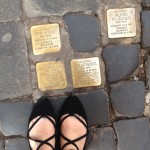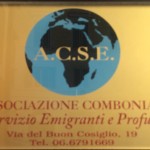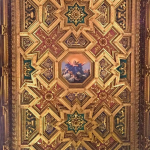Working with the poor and good reporting have something in common.
Professor Goldman likes to say that there is no free time on our trip to Italy; only reporting time. Our third day was a rather unscheduled one, which meant that we were off in many different directions to do what we came here to do: report. The focus of much of the reporting was on the condition of immigrants and refugees. We visited church organizations that are working to help the newcomers find jobs and housing, learn Italian and even get driver’s licenses. Perhaps appropriately, we wrapped up the day with a visit to Sant’Egidio, a Catholic community that works with the poor in the hope of lifting them out of poverty. Here is a sampling of what our reporters covered on Monday:
Chavie Lieber

(Chavie Lieber / Religio)
Chavie went to interview a source at the Great Synagogue of Rome and got a tour of the neighboring Jewish museum. After the synagogue, she visited a café in what was once the Jewish ghetto. The area is a small, just four square blocks, and quite charming. There are numerous restaurants with “kosher” signs in the window. Chavie said that couldn’t help but feel comforted being among her people.
She also explored the streets that had Stolperstein, the copper stumbling stones German artist Gunter Demnig created that protrude from cobblestone sidewalks and commemorate victims of Nazi persecution.
Divya Kumar
In the afternoon, Divya went to Villa del Solaria, at the outskirts of Rome, where the Roma people, also known as the gypsies, are living in temporary housing. Advocate groups have said they are being pushed out after prominent politicians this year have said they wanted to raze their living sites. Though someone guarding the temporary housing settlement said journalists were not able to enter the site, Divya was able to walk around a bit and observe the site as well as some Roma settlements, many with tin-roofed dwellings and broken windows. The poverty was a sharp contrast to what one sees in the rest of Rome.
Vicky Huang
After a brisk breakfast at Hotel Emmaus, Vicky went to visit a Catholic church where migrants from different countries have been offered to take Italian classes for free. There she interviewed the teacher who had been a journalist for 35 years before becoming a volunteer teacher at this church. During lunch, she interviewed a Chinese Italian source whose experience of growing up in heavily Catholic Italy sheds light on the larger cultural implications for my big project story.
Emily Neil
Emily went to the Grand Mosque of Rome and interviewed the secretary general of the Islamic Cultural Centre of Rome, Abdellah Redouane. Though Islam is not officially recognized by the Italian government, a recognition that affords a religious denomination certain legal privileges, Redouane said the Islamic Cultural Centre of Rome, along with the Grand Mosque of Rome, is expecting a visit from Pope Francis soon. After the visit, it is planning to present to the government following the visit to once again make a case for official recognition. Following the interview with Redouane, Emily was given a tour of the Grand Mosque’s library, which holds a number of ancient Qur’ans, along with other texts about Islamic theology, literature, and history.
Cydney Tucker

(Katie Shepherd / Religo)
Cydney travelled to section of Rome called Monti where she visited the Associazione Comboniana Servizio Emigranti e Profughi, a local Nigerian immigrant church. The church provides several immigrants with Italian and English language classes. From 9 to 11 a.m., Cydney sat in on the Italian language class where individuals from countries such as Gambia, Ghana, Iran, and the Philippines were present.
Armando Torres-Garcia
Two weeks ago, Rome welcomed its first Syrian refugees. Leaders from Sant’Egidio Community, and the Federation of Evangelical Churches joined forces and brought 23 Syrians to the area. Armando went to the evangelical group’s headquarters to learn where they ended up. He got permission to visit a migrant center right out of Rome where some of the migrants are living.
Lora Moftah
Lora spent the day reporting around Piazza Sant’Egidio, the main headquarters of the Community of Sant’Egidio. She took photos and spoke to worshippers in the Basilica of Santa Maria di Trastevere, where the community gathers for their evening prayer service and where the Religio team later attended a Sant’Egidio vespers.
Toward evening, our entire group gathered at an old convent in the Trastevere section of Rome to meet with Claudio Bette, an official of Sant’Egidio, who told us about the work of the lay Catholic organization. Established in 1973, Sant’Egidio focuses on working with the poor to try to address what it sees as injustices in the world. Bette said Pope Francis’s focus on “changing the church to change the world” encompasses the spirit of Sant’egidio.

The ceiling of Basilica di Santa Maria en Trastevere, where Sant’Egidio meets to pray. (Santiago Melli-Huber / Religio)
There are three words that are important for working with the poor, Bette said. “See, talk and touch, but especially touch.” He was talking about the work of charitable organizations but in some ways he was also describing what good reporters do. His advice – see, talk, touch – resonated for so many of us who have been striving tell truthful stories about Italy’s marginalized residents.
Bette emphasized the importance of good journalism about the poor since the media often portrays them with scare words like “invasion” and “flood,” particularly when it comes to refugees. The story that needs to be told, he said, is that Europe, with 740 million people, has room for immigrants and that they could be a boon to such countries as Italy with its aging population.
From the convent, we took a short walk to Santa Maria di Trastevere, where we heard short vespers service led by members of the Catholic organization. From there, it was time for nightly dinner, which has become a time for us to refresh, regroup and share our experiences with one another. We went to a popular restaurant called Popi Popi to feast on authentic Italian pizza. We’ll need the energy for our last day of reporting in Rome, where many of us will be seeing, talking and walking among some of the city’s least visible communities.